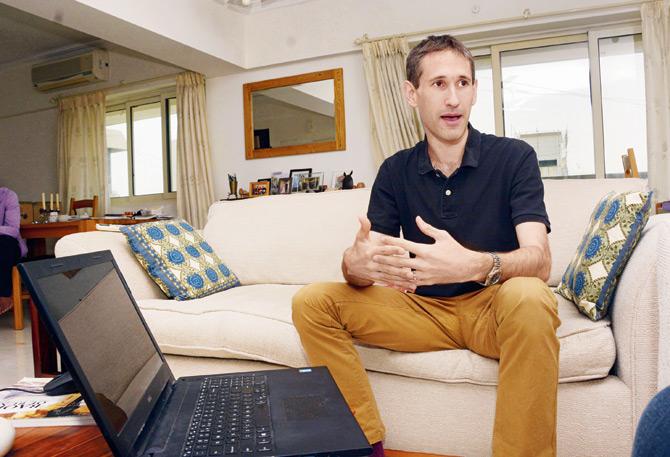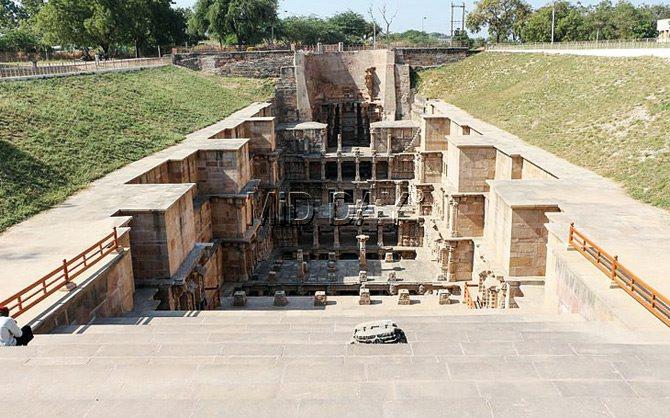Mumbai-based British scientist Philip Earis has launched a web atlas to locate and preserve an ancient architectural marvel that’s unique to India

Philip Earis has spent eight months gathering material on stepped architecture for his collaborative website.
Bandra resident Philip Earis remembers treading through a narrow, descending stone stairway while visiting a fort in Rajasthan a few years ago. When he finally made it to the bottom, the steps opened into a cavernous water hole. “Until then, I hadn’t seen anything as impressive,” says the Mumbai-based British scientist about the ancient stepwell in Chittorgarh. “But very few people knew about the site.”
ADVERTISEMENT

Philip Earis has spent eight months gathering material on stepped architecture for his collaborative website.
Pic/Pradeep Dhivar
Now, as he takes us through a series of photographs on his recently-launched website, Atlas for Stepwells (www.stepwells.org), Earis says he felt something needed to be done about the relatively unknown architectural and engineering marvel, unique to India and some South Asian countries. His persistence and growing obsession led him to track down more stepwells across the country. Then came the website — an online collaborative map and information pool for stepwells in India, and abroad.

Rani ki Vav in Patan, Gujarat (11th century AD)
The 33-year-old scientist has been partially successful, having collated information on over 300 stepwells in the country, in over just about eight months. He estimates that there could be around 1,500 hidden stepwells in the country.
“Unfortunately, many are in a state of neglect,” he says. “At present, only 46 stepwells have been preserved by the Archaeological Survey of India (ASI),” says Earis.
_at_Abhaneri.jpg)
Chand Baori near Abhaneri, Rajasthan (800-900 AD)
His website, which went live in April, is a compilation of the many stepwells in the country, including their location on the map, its history and photographs.
Traditionally, stepwells were designed to collect and store ground water for people living in nearby areas. A majority of them were constructed in the arid, western belt of Haryana, Gujarat, Rajasthan and Maharashtra, but stepwells can be found across India.
“These impressive, subterranean structures were also centralised meeting places for people, because the temperature at the bottom of the steps is six degrees lower than at the surface.”
Some stepwells also held religious significance and had shrines built around them. One such example is the Modhera stepwell in Gujarat, which is home to the Sun Temple.
Stepwells were, however, predominantly created to serve as a reservoir — a purpose, which Earis says has been lost to people, especially the locals. “Many aren’t even aware that something like this exists in their backyard.” A case in point are popular tourist sites such as the Taj Mahal, Agra Fort and Humayun’s Tomb in Delhi.
“Most stepwells have run dry because of the overuse of ground water in nearby areas,” adds Earis.
Many fell into ruin during the British rule. “The British considered stepwells an unhygienic source of water, and did not make any attempt to restore the structures,” says Earis, while discussing material from books like Steps to Water:
The Ancient Stepwells of India by Morna Livingston. “Many stone structures were eventually reduced to rubble.”
According to him, the need of the hour is to preserve these sites. “The stepwell is the Indian solution to an Indian problem,” he says, while referring to the drought that’s gripped the country. “India has been investing thousands of crores in irrigation and dam projects. But historically, stepwells were the localised solution to meet the water needs of villagers,” says Earis.
With Atlas for Stepwells, he hopes to put the ancient structures back on the Indian map. Earis first began collecting information in August last year.
A decent number of stepwells mentioned on his site were located by Earis, while travelling the length and breadth of the country. For the rest, he relied on material available on the Internet, including travel blogs, the ASI, newspaper articles, the documented works of his journalist friend Victoria Lautman, as well as books (like Livingston’s). Earis has been gathering material since August last year.
“The purpose of this entire exercise was not just to have a list, but to collate photographs and data, including the accurate location (GPS coordinates), so that people could easily find remotely-located stepwells,” he says, adding that this involved constant liaisoning with locals and going through satellite images on Google Earth.
This first-of-its-kind portal is a collaborative space, where users can register and share news, photographs and information about notable stepped water architecture. The site also has an events calendar, which will update users on any event, tour or talk related to stepwells. Similarly, the books and documents section, which is yet to be updated, will link users to written material related to stepped-architecture.
Currently, Atlas for Stepwells has opened itself to over 25 countries, with people sharing information in places as far as Indonesia, Cambodia, UK, Portugal and Spain. But of the 400 stepwells listed, only 100 have been located outside India.
“What’s interesting is that a couple of the seven stepwells (like Monesma in Aragon) that we located in north-western Spain, look very similar to those in India,” he adds.
Earis, who works as an environment project coordinator with a variety of organisations, including the Observer Research Foundation (ORF) and Indian Institute of Science in Bengaluru, will be completing his three-year stint in the country this June, after which he plans to return to the UK. He, however, hopes that this project will keep him connected to India. “Eventually though, I want Indians to take complete ownership of this project, and carry my work forward,” says Earis, who has a busy schedule lined up in Nagpur, where he will be spending days in the scorching heat, looking for what else, stepwells.
 Subscribe today by clicking the link and stay updated with the latest news!" Click here!
Subscribe today by clicking the link and stay updated with the latest news!" Click here!








